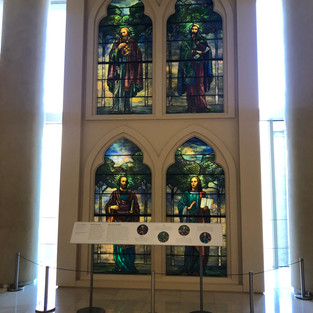Challenges and Choices in a Private Museum
- SMC History

- Feb 2, 2020
- 4 min read
BY JULIETTE GARCIA
Museums often present numerous opportunities for visitors to analyze, interpret, and evaluate artifacts and exhibits. This allows individuals to consider their own perspectives on history, and develop a sense of historical empathy. For the case of the Bible Museum, the fact that the Bible is the most recognized book in the world, it allows for many different interpretations. According to Alan Marcus, Jermey Stoddard, and Walter Woodward in their book, “Teaching History with Museums,” museums can be viewed as legitimate and relevant, yet operating within a subjective and constructed set of perspectives.” [1] This theoretical framework applies well to the Museum of Bible, with the presumption that the museum would tailor more towards Christianity, surprisingly enough leaves all visitors with a valuable sense of the impact of the Bible in the lives people all over the world.
The Museum of the Bible is a private museum displaying the history of the impact of the Bible from its earliest days, to today. The Bible has created controversy over the centuries for because of the continuous disagreements between Christians and Jews. Therefore, overtime the interpretations of the Bible has become a symbol of and most applicable to Christianity. The museum is a 430,000-square-foot building that is located a few blocks from the U.S. Capitol in Washington, D.C., and only 10 minutes away from the National Mall.[2] It is probably the most modern and beautiful museum I have ever visited. I was in complete awe of the architecture, aesthetic and overall experience, which is technologically advanced and has six overwhelmingly engaging floors. It took me three hours to get through the entire museum.
To my fascination, the museum exhibits many rare and intriguing artifacts ranging from thousands of years of history to today. It also offers visitors an immersive and personalized experience with the Bible, through interactive walk-through tours, sit-down shows, interactive displays and artifacts. The museum cost $500 million to produce.[3] I was surprised to have found out that the museum only took two years to build. The amount of work they did to achieve the level of detail, research and collecting in the museum was probably very extensive. The museum sought to make the experience enjoyable, engaging, and welcoming to all. From showing artwork and artifacts from the Vatican, the beautiful stained glass murals on every, to the marble aesthetic of the entire museum, you are constantly in awe of the beauty and history. Visitors of all religions, or none at all, would be impressed with the museum.
The museum immerses you into the Bible from many different interpretations. Starting at the bottom of each floor, you are welcomed with a beautiful set of sets leading you up to a stained glass mural, from there you continue on to exhibits such as "Inventors of the Alphabets” from the Vatican Library, The Impact of the Bible, The Stories of the Bible, and The History of the Bible. Therefore, what I realized was that the museum left interpretations open to be considered solely by the visitor. Each exhibit engaged in different countries, view points and solid evidence from the bible and history. For example, the exhibit “The History of the Bible,” was nearly an entire floor dedicated to Bibles from around the world. Countries of the Middle East, Africa, United States, and Europe were all included. You can see how each country included their own imagery and translation to tailor to their people.
Yet, the main controversy surrounding this museum lies with the fact that the museum is being funded by conservative Christian family-run companies, like the Green family, which owns Hobby Lobby. According to journalist Tara Isabella Burton, “the Green family devotes a staggering percentage of its Hobby Lobby earnings — reportedly about half of the company’s pretax income — to evangelical outreach and faith-based charity work. Much of this outreach is specifically devoted to ministry; the Greens have, for example, placed newspaper ads in order to remind readers of the ‘real meaning’ of Christmas, and have supported Christian educational institutions like Oral Roberts University, to which they donated $70 million.”[4] Yet, even with their immense amount of donations, they are still charging guests for admission. Therefore, it is questionable as to why visitors of other religious groups would even bother visiting a museum that does not relate to them?
Although the assumption of the museum would be tailored to Christianity, I was impressed with how the museum continuously showed Global view of the impact of the Bible, and displayed its history throughout many countries over time. Exhibits included examples of daily life in Nazareth, the Old Testament, and the New Testament from the Vatican, art work, and Bibles from nearly every country and era since its creation. Non-Christian visitors such as Muslims, Agnostics, and Atheists can find appreciation in the museum for its vast collection of artifacts, its beauty, and because you can consider the Bible without feeling limited to a Christian perspective.
Since its opening the museum’s mission has become “inviting all people to engage with the Bible.” Therefore, it hopes that by exhibiting the Bible and its history that visitors will be able to interpret the meaning of the Bible in their own lives and to see how the Bible plays a role in life around the world. The Museum prides itself on education and research, which it effectively displays. There is so much to learn about not only the Bible, but how the Bible has played a role in society throughout the years through fashion, media, politics, and organized religion. Being that the Bible is the most recognized book in the world, this museum will resonate with many visitors. Interpretations are completely up to you.
[1] Marcus, Alan S., Jeremy D. Stoddard, and Walter William Woodward. Teaching History with Museums: Strategies for K-12 Social Studies. New York: Routledge, 2017.
[2] “One of Fodor's Best Museums in DC.” Museum of the Bible. Accessed February, 2020. https://www.museumofthebible.org/.
[3] “One of Fodor's Best Museums in DC.” Museum of the Bible. Accessed February, 2020. https://www.museumofthebible.org/.
[4] Burton, Tara Isabella. “A Bible Museum Is a Good Idea. The One That's Opening Is Not.” Vox. November 17, 2017.
















Comments